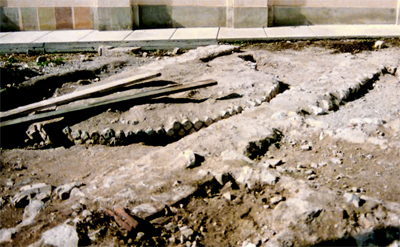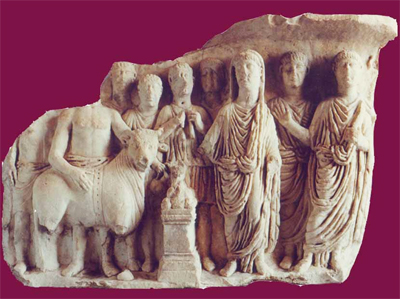From Grumentum to Saponariaby Vincenzo Falasca
In the Hagiography of S. Laverio, written by the saponariense Canon in the 1162, the first Saracen attack to Grumentum is placed under the pontificate of John VIII and exactly around the year 878. In that year the people of Grumentum began to dislocate into the territory. Afterwards the roman city was definitively destroyed in 1031. But it is possible to assume a first dislocation of Grumentum people in the neighbourhood even after the end of the fifth century following the Gothic invasions and the permanence of some of them in the northern side of the Grumentum hill. The sites of the first decentralization may have been Casal Pedone or Grumentino and Santa Lucia. After the first two devastations by the Saracen bands (878 and 896), Grumentum people realized that would have been impossible to defend against further attacks, so they moved their houses to location placed in a higher level. Niccolò Ramaglia talks about the foundation of seven “Pagus” or “Hamlets”: Santa Lucia, Grumentino, Tramutola Vecchia ai Rungi, San Rato and San Giuliano. He omits, however, the names of two hamlets. One of them could be placed just on the hill of Saponaria, where already from the fourth century A.C. was built a little hamlet around a small roman temple.
Long time before the last Saracen incursion, (perhaps around the year 960), the Bishop of Grumentum named Joannes fled to Marsico. Niccolò Ramaglia, notary and Prosecutor of Collegiate church of Saponaria around the beginning of the eighteenth century, places the birth of the City in 954, when Donato Leopardo, archpriest of Santa Maria Assunta sat at the head of Grumentum people survivors and led them on the opposite hill (where currently is Grumento Nova) and founded a small village. Afterwards it was feoffed, around 1060, Roberto I d’Altavilla, Count of Montescaglioso and his son Guglielmo, whom they called “Saponaria”.
On the small temple was built in 1118 the Cathedral church of the village. The bas-relief is the irrefutable evidence that around the tiny Serapeum was built an hamlet, composed of a few houses. Not surprisingly, the first large group of houses in that area was called Casaletto. |




 Roselli, speaking about the foundation of new built-up areas by Grumentum people refugees, said :” They set to built various hamlets, such as Sarconi, Moliterno, Marsico Vetere, Viggiano, Montemurro, Spinoso, Armento, S. Martino, and others etc.’’.
Roselli, speaking about the foundation of new built-up areas by Grumentum people refugees, said :” They set to built various hamlets, such as Sarconi, Moliterno, Marsico Vetere, Viggiano, Montemurro, Spinoso, Armento, S. Martino, and others etc.’’. The recent refurbishments of the area surrounding the Cathedral church (made around 1998) have shown that the hill where is Grumento Nova had already been occupied in partial form by the ancient inhabitants of Grumentum, that had built up there among the III-IV century A.C. a small temple probably dedicated to the eastern god
The recent refurbishments of the area surrounding the Cathedral church (made around 1998) have shown that the hill where is Grumento Nova had already been occupied in partial form by the ancient inhabitants of Grumentum, that had built up there among the III-IV century A.C. a small temple probably dedicated to the eastern god